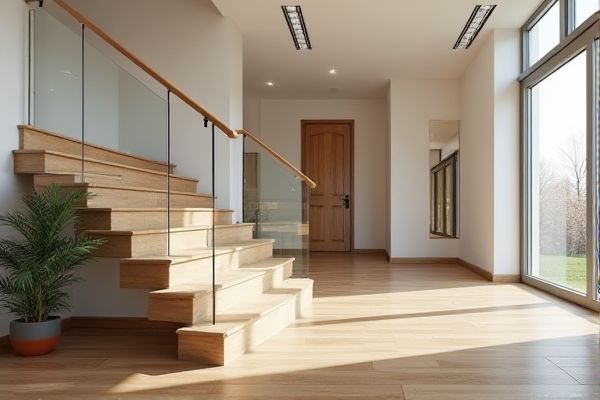
Floating stairs offer a modern, open aesthetic and create a sense of spaciousness by minimizing visible supports, contrasting with traditional stairs that emphasize solid structures and classic designs. Discover the key differences and benefits of each option to determine which staircase style best fits your space and lifestyle.
Table of Comparison
| Feature | Floating Stairs | Traditional Stairs |
|---|---|---|
| Design | Modern, minimalist, open | Classic, enclosed, solid |
| Material | Glass, metal, wood | Wood, concrete, metal |
| Installation | Complex, requires specialized support | Standard, easier to install |
| Space Usage | Maximizes visual space, less bulky | Consumes more visual and physical space |
| Safety | Requires railing, may feel less secure | Generally safer with enclosed steps |
| Cost | Higher due to design and materials | Typically lower, cost-effective |
| Maintenance | Needs regular cleaning, careful upkeep | Durable, easier maintenance |
| Visual Impact | Light and airy, visually striking | Traditional aesthetic, solid appearance |
| Use Case | Best for modern homes, open concepts | Suitable for all home styles |
Introduction to Floating Stairs and Traditional Stairs
Floating stairs feature open risers and minimal support structures, creating a sleek, modern aesthetic that enhances visual space and light flow in interiors. Traditional stairs, characterized by closed risers and substantial stringers, provide classic stability and are often constructed from wood, concrete, or metal for durability and timeless appeal. Choosing between floating and traditional stairs depends on design preferences, structural requirements, and spatial limitations.
Design Aesthetics: Modern vs Classic Appeal
Floating stairs offer a sleek, modern aesthetic characterized by open risers and minimalistic structures that create a sense of spaciousness and contemporary elegance. Traditional stairs feature solid risers and ornate details, evoking a classic, timeless appeal that complements more conventional interior designs. Your choice between floating and traditional stairs will significantly influence the overall style and atmosphere of your living space.
Space Efficiency and Layout Considerations
Floating stairs offer superior space efficiency by creating an open, airy feel that visually expands your room, unlike traditional stairs which occupy more floor space and require bulky supports. Their minimalist design allows for flexible layout options, making them ideal for tight or modern interiors where maximizing usable area is crucial. Choosing floating stairs can significantly enhance your home's spatial flow and aesthetics without compromising functionality.
Structural Strength and Safety Features
Floating stairs utilize cantilevered treads anchored directly into the wall, providing robust structural strength while maintaining an open, modern aesthetic. Traditional stairs rely on stringers and risers that distribute weight evenly and offer inherent stability. Your choice should consider safety features such as handrails and non-slip surfaces, with traditional stairs typically offering more built-in support, whereas floating stairs require precise installation to meet safety standards.
Installation Process and Complexity
Floating stairs require a more complex installation process due to their reliance on hidden supports and precise anchoring to walls or structures, demanding skilled craftsmanship and specialized tools. Traditional stairs feature a more straightforward installation, with visible stringers and treads that can be assembled using standard carpentry techniques. Your choice impacts the installation timeline and cost, with floating stairs typically requiring more time and expertise.
Material Options for Both Stair Types
Floating stairs often feature materials like tempered glass, steel, and hardwood, combining modern aesthetics with structural integrity. Traditional stairs commonly utilize solid wood, concrete, and wrought iron, offering durability and classic design versatility. Both stair types can be customized with various finishes and treatments to enhance safety and complement interior decor.
Cost Comparison: Initial and Long-Term Expenses
Floating stairs typically involve higher initial costs due to specialized materials and installation techniques, often ranging from 20% to 50% more than traditional stairs. Over time, maintenance expenses for floating stairs can be lower because of durable, modern materials like steel and tempered glass, whereas traditional wood stairs may require frequent refinishing and repairs. Long-term expenses also consider potential resale value increases with floating stairs, which often enhance home aesthetics and market appeal compared to conventional stair designs.
Maintenance and Durability Factors
Floating stairs typically require less maintenance due to their minimalist design and use of durable materials like steel and tempered glass, which resist wear and corrosion better than traditional wood. Traditional stairs, often constructed from hardwood or carpeted surfaces, may demand frequent cleaning, refinishing, or repairs due to scratches, stains, and moisture damage. Your choice should consider that floating stairs offer a longer lifespan with lower upkeep costs, while traditional stairs might need more regular attention to maintain their appearance and structural integrity.
Suitability for Different Interior Styles
Floating stairs complement modern and minimalist interior styles by providing a sleek, open aesthetic that enhances natural light and spatial flow. Traditional stairs suit classic and rustic interiors with their solid construction and detailed craftsmanship, adding warmth and architectural character. Both types can be customized with materials like wood, metal, or glass to better match specific design themes.
Choosing the Right Staircase for Your Home
Floating stairs create an open and modern aesthetic by using hidden supports, making spaces appear larger and more contemporary compared to traditional stairs that rely on visible stringers and risers for a classic, sturdy design. Your choice depends on factors like space availability, safety preferences, and interior style, with floating stairs offering sleek minimalism and traditional stairs providing timeless durability. Consider the flow of natural light and your home's architectural theme to select the staircase best suited for both function and visual impact.
 homyna.com
homyna.com